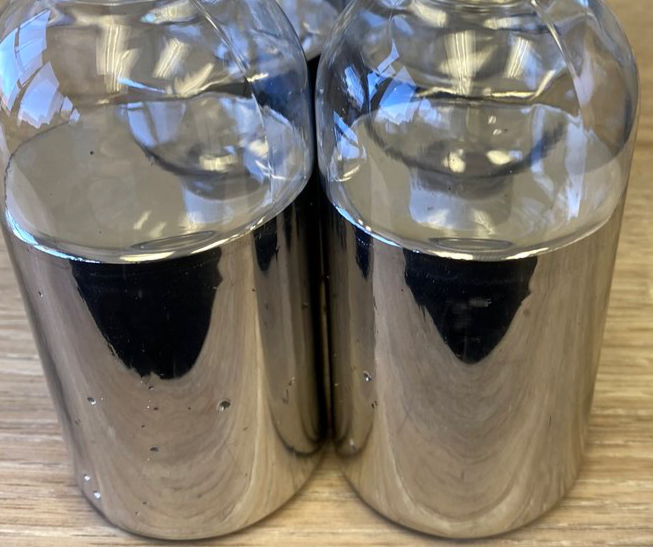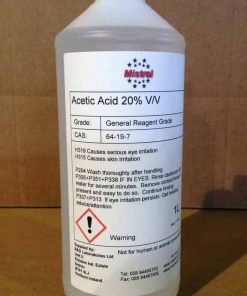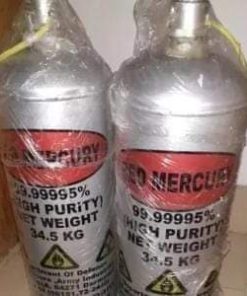Silver Liquid Mercury
$1,250.00 – $8,500.00Price range: $1,250.00 through $8,500.00
Where to buy silver liquid mercury online
Most people are familiar with mercury and several other products. But still, when it comes to silver liquid mercury for sale it is important to know whether the supplier has the quality or not.
Liquid Silver And Liquid Red Mercury For Sale High Purity Silver Liquid Mercury We have Silver Liquid Mercury used for Gold Processing and other uses for sale. Its purity is 99.999%.
Buy Silver Liquid Mercury Online | Available in the UK, France, USA, Canada & Worldwide
Silver Liquid Mercury, known chemically as Hg, is a heavy, silvery metal that remains liquid at room temperature, making it a rare and valuable element for various industrial and scientific uses. If you’re interested in learning more about its unique chemical properties, you can explore detailed information on our Mercury Chemical Properties page. Silver Liquid Mercury is widely used in applications such as Gold Mining and as a catalyst in chemical synthesis. Due to its toxic nature, understanding safe handling practices is essential — resources like the World Health Organization (WHO) and the Environmental Protection Agency (EPA) offer critical safety guidelines to prevent exposure risks. For purchasing, our Silver Liquid Mercury For Sale section provides high-purity products with secure shipping across the UK, USA, Canada, and France.
What is Silver Liquid Mercury?
Silver Liquid Mercury, identified by the chemical symbol Hg and atomic number 80, is a fascinating chemical element often referred to as quicksilver. Historically known as hydrargyrum, this heavy, silvery metal is unique because it remains in liquid form at standard temperature and pressure, making it the only metallic element with this property. Apart from mercury, only bromine exists as a liquid at these standard conditions, while metals like cesium, gallium, and rubidium melt slightly above room temperature. Mercury is naturally found in deposits worldwide, primarily in the form of cinnabar (mercuric sulfide), which is ground to produce the red pigment vermilion. Due to its distinctive physical and chemical properties, mercury has been a critical element in various industries and scientific fields.
The Controversial Nature of Silver Liquid Mercury
Silver Liquid Mercury is often discussed not only for its industrial use but also for its controversial reputation as a potentially powerful chemical explosive. While many experts have long dismissed claims about its explosive capabilities as myth, recent leaks from countries like South Africa, Russia, and the United States suggest that this chemical’s potential risks might be more than speculation. These revelations have prompted nuclear weapons scientists worldwide to reconsider the seriousness of silver liquid mercury as a factor in nuclear proliferation. This ongoing debate adds a geopolitical dimension to mercury’s global importance and highlights why monitoring its trade and use is critical for international security.
Historical and Modern Uses of Silver Liquid Mercury
Since the Industrial Revolution, silver liquid mercury has been in high demand. It was in 1799 that mercury fulminate was first employed as a detonator in explosives, marking mercury’s vital role in military and mining applications. Later, in 1835, the synthesis of polyvinyl chloride (PVC) began, with mercury used as a catalyst in its production. This historical significance established a network of specialized suppliers and dealers of liquid mercury worldwide. Today, mercury continues to be used across industries, but its well-documented toxicity and environmental persistence mean that reducing its anthropogenic release is essential. Given mercury’s ability to travel across borders via air and water, international coordination and negotiation are critical to managing its safe use and minimizing environmental impact.
Packaging and Physical Properties of Silver Liquid Mercury
Due to mercury’s toxicity and hazardous nature, it is transported and stored under stringent safety standards. Packaging options include 34.5 kg virgin steel flasks, 76 lb virgin steel flasks, and large 2204 lb reusable steel containers, along with glass and polyethylene bottles for smaller quantities. These containers comply with international safety and transportation regulations to ensure secure handling. Silver Liquid Mercury has a molecular weight of 200.59, appears as a silver-white liquid, melts at -39 °C, boils at 356.6 °C, and has a density of 13.534 g/cm³. It is insoluble in water but remains a significant environmental hazard due to its persistence and bioaccumulation.
Advanced Information and Production
An intriguing aspect of silver liquid mercury is its production method in some regions, notably involving irradiation of elemental mercury with mercury antimony oxide in Russian nuclear reactors. This process contributes to the controversial nature of “red mercury,” a substance rumored to be highly explosive and potentially capable of triggering fusion reactions in tritium or deuterium-tritium mixtures. Although heavily debated and often dismissed by the scientific community, new intelligence leaks have compelled experts to take potential risks more seriously. This places mercury at the center of both scientific inquiry and global security discussions.
Health and Safety Considerations
Mercury’s toxicity cannot be overstated. Classified as a highly dangerous chemical, it carries severe health risks including neurological damage, respiratory harm, and reproductive toxicity. It is linked to hazard codes T+ and Xn, with precautionary statements emphasizing the use of respiratory protection, avoidance of environmental release, and strict disposal protocols. Exposure to mercury vapor can damage the nervous, digestive, and immune systems. The tragic historical case of Minamata disease in Japan illustrated mercury’s devastating effects, with symptoms including seizures, muscle coordination loss, and sensory impairments. Pregnant women exposed to mercury are at high risk of delivering babies with congenital disabilities, underscoring the importance of careful mercury handling and regulation.
Why Mercury is Used in Gold Mining
One of the most common modern uses of mercury is in artisanal and small-scale gold mining. Mercury forms an amalgam with gold particles found in soil and sediment, making it easier to extract minute gold pieces. This process, while effective for gold recovery, poses significant environmental and health risks due to mercury’s toxicity and potential to contaminate waterways and aquatic life. Regulatory agencies in the USA, Canada, and Europe actively promote safer alternatives to mercury in mining, but challenges remain in parts of the world where mercury use is still widespread.
Buy Silver Liquid Mercury Online from Trusted Suppliers
If you are looking to buy silver liquid mercury online, it is crucial to source it from a reputable and compliant supplier. We are a trusted supplier based in the USA, serving customers across the UK, France, Canada, and worldwide. Our silver liquid mercury is ultra-high purity (99.9995%), triple distilled, and handled with the highest standards for safety and quality. Whether for industrial, scientific, or mining applications, our products meet stringent international regulations and come with comprehensive health and safety information.
Before purchasing mercury online, always verify the supplier’s authenticity, customer reviews, and compliance with transport laws to avoid legal and safety issues. We offer secure payment methods, professional customer support, and safe shipping options worldwide. Our bulk and retail mercury products are trusted by industries and individuals globally.
Where to Buy Silver Liquid Mercury Online Safely
Buying silver liquid mercury online requires careful consideration. Our company has operated for many years as a reliable and affordable supplier, prioritizing product quality and customer safety. When purchasing from us, you benefit from a transparent ordering process, secure payments, and dedicated customer service ready to assist you with any inquiries. Our team is knowledgeable, friendly, and committed to ensuring your satisfaction.
We invite you to explore our inventory of mercury products, including bulk quantities for commercial use. With a strong reputation in a competitive market, we take pride in providing the best silver mercury available online.
Keywords for SEO & Geo-targeting
Buy silver liquid mercury online UK | Silver mercury for sale USA | Pure liquid mercury Canada | Mercury chemical supplier France | Red mercury explosive claims | Mercury for gold mining worldwide | Safe mercury purchase online | High purity mercury suppliers
If you want, I can also help you craft meta titles, descriptions, or create FAQ schemas to further boost your site’s SEO. Would you like me to do that?
The release, absorption and possible health effects of mercury from dental amalgam: a review of recent findings
Mercury is a highly potent cellular toxin that affects both human and animal nervous systems. In developed countries, mercury vapour released from dental amalgam fillings is the predominant source of mercury exposure to the adult and fetal central nervous system. Only small populations with high consumption of methylmercury-contaminated fish experience mercury exposure from fish that can match or exceed that from amalgam fillings.
The most severe health risk posed by mercury vapour is its interference with fetal and child brain development. This neurotoxic effect has been demonstrated in animal studies involving monkeys and rats, as well as in nerve cell cultures exposed to nanomolar concentrations of mercury. Epidemiological studies also support these findings, showing adverse effects in women occupationally exposed to mercury vapour during pregnancy. However, currently, no data exist to establish clear dose-response relationships for this effect in humans.
Mercury Toxicity and Its Impact on Human Health
In populations with occupational exposure to mercury vapour, epidemiological studies have observed subclinical effects on the kidneys, immune system, thyroid function, and central nervous system at exposure levels comparable to the highest range seen in individuals with amalgam fillings, as measured by urinary inorganic mercury excretion.
The cellular toxicity of mercury likely stems from its ability to alter the tertiary and quaternary structures of proteins. Since protein structures are genetically determined, there is significant potential for genetic polymorphisms to influence individual sensitivity and reactions to mercury exposure. It is also plausible that mercury exposure from dental amalgam could cause side effects similar to those seen with potent pharmaceuticals.
Available epidemiological evidence suggests that the incidence of side effects from mercury exposure via amalgam fillings is unlikely to exceed 10%, with an incidence closer to 1% or lower being more probable. Given these risks, it is recommended that the use of amalgam for dental restorations be phased out in favor of less toxic alternatives. Furthermore, amalgam restorations should especially be avoided in children and women of childbearing age due to the potential risks to brain development.
| Qunantiy | 1/2 Flask, 1 Flask, 2 Flasks, 3 Flasks, 4 Flasks, 5 Flasks |
|---|
Be the first to review “Silver Liquid Mercury” Cancel reply
Related products
FEATURED
FEATURED
FEATURED
FEATURED













Reviews
There are no reviews yet.